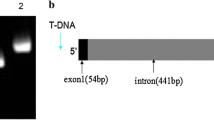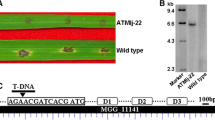Abstract
During the colonization of tomato leaves, the fungal pathogen Cladosporium fulvum excretes low-molecular-weight proteins in the intercellular spaces of the host tissue. These proteins are encoded by the ecp genes which are highly expressed in C. fulvum while growing in planta but are not, or are only weakly, expressed in C. fulvum grown in vitro. To investigate the function of the putative pathogenicity gene ecp2, encoding the 17-kDa protein ECP2, we performed two successive disruptions of the gene. In the first of these, the ecp2 gene was interrupted by a hygromycin B resistance gene cassette. In the second gene disruption, the ecp2 gene was completely deleted from the genome, and replaced by a phleomycin resistance gene cassette. Both disruption mutants were still pathogenic on tomato seedlings, indicating that the C. fulvum ecp2 gene is not essential for pathogenicity in tomato.
Similar content being viewed by others
References
Bhairi SM, Staples RC, Freve P, Yoder OC (1989) Characterization of infection structure-specific genes from the rust fungus Uromyces appendiculatus. Gene 81:237–243
Danhash N, Wagemakers CAM, Van Kan JAL, De Wit PJGM (1993) Molecular characterization of four chitinase cDNAs obtained from Cladosporium fulvum-infected tomato. Plant Mol Biol 22:1017–1029
De Wit PJGM (1977) A light and scanning-electron microscopic study of the infection of tomato plants by virulent and avirulent races of Cladosporium fulvum. Neth J Plant Pathol 83:109–122
De Wit PJGM, Spikman G (1982) Evidence for the occurrence of race- and cultivar-specific elicitors of necrosis in intercellular fluids of compatible interactions of Cladosporium fulvum and tomato. Physiol Plant Pathol 21:1–11
De Wit PJGM, Buurlage MB, Hammond KE (1986) The occurrence of host, pathogen and interaction-specific proteins in the apoplast of Cladosporium fulvum (syn. Fulvia fulva)-infected tomato leaves. Physiol Mol Plant Pathol 29:159–172
De Wit PJGM, Van den Ackerveken GFJM, Joosten MHAJ, Van Kan JAL (1989) Apoplastic proteins involved in communication between tomato and the fungal pathogen Cladosporium fulvum. In: Lugtenberg BJJ (ed) Signal molecules in plants and plant-microbe interactions. Springer, Berlin Heidelberg New York, pp 273–280
Dickman MB, Podila GK, Kolattukudy PE (1989) Insertion of a cutinase gene into a wound pathogen enables it to infect an intact host. Nature 342:446–448
Drocourt D, Calmels TPG, Reynes JP, Baron M, Tiraby G (1990) Cassettes of the Streptoalloteichus hindustanus ble gene for transformation of lower and higher eukaryotes to phleomycin resistance. Nucleic Acids Res 18:4009
Ellingboe AH (1976) Genetics of host-parasite interactions. In: Heitefuss R, Williams PH (eds) Encyclopedia of plant physiology, NS, vol 4: Physiological plant pathology, Springer, Heidelberg Berlin New York, pp 761–778
Hahn MG, Bucheli P, Cervone F, Doares SH, O'Neill RA, Darvill A, Albersheim P (1989) Roles of cell-wall constituents in plant-pathogen interactions. In: Kosuge T, Nester EW (eds) Plant-microbe interactions, vol 3. McGraw-Hill, New York, pp 131–181
Hamer JE, Howard RJ, Chumley FG, Valent B (1988) A mechanism for surface attachment in spores of a plant pathogenic fungus. Science 239:288–290
Harling R, Kenyon L, Lewis BG, Oliver RP, Turner JG, Coddington A (1988) Conditions for efficient isolation and regeneration of protoplasts from Fulvia fulva. J Phytopathol 122:143–146
Heath MC (1981) A generalized concept of host-parasite specificity. Phytopathology 71:1121–1123
Heath MC (1982) The absence of active defence mechanisms in compatible host-pathogen interactions. In: Woods RKS (ed) Active defence mechanisms in plants. Plenum Press, New York London, pp 143–156
Joosten MHAJ, De Wit PJGM (1988) Isolation, purification and preliminary characterization of a protein specific for compatible Cladosporium fulvum (syn. Fulvia fulva)-tomato interactions. Physiol Mol Plant Pathol 33:241–253
Joosten MHAJ, De Wit PJGM (1989) Identification of several pathogenicity-related proteins in tomato leaves inoculated with Cladosporium fulvum (syn. Fulvia fulva) as 1,3-glucanases and chitinases. Plant Physiol 89:945–951
Joosten MHAJ, Bergmans CJB, Meulenhoff EJS, Cornelissen BJC, De Wit PJGM (1990) Purification and serological characterization of three basic 15-kilodalton pathogenicity-related proteins from tomato. Plant Physiol 94:585–591
Joosten MHAJ, Cozijnsen TJ, De Wit PJGM (1994) A fungal tomato pathogen circumvents host plant resistance by a single base pair change in an avirulence gene. Nature 367:384–386
Lazarovits G, Higgins VJ (1976) Histological comparison of Cladosporium fulvum race 1 on immune, resistant, and susceptible tomato varieties. Can J Bot 54:224–234
Linthorst HJM (1991) Pathogenesis-related proteins of plants. Crit Rev Plant Sci 10:123–150
Marmeisse R, Van den Ackerveken GFJM, Goosen T, De Wit PJGM, Van den Broek HWJ (1993) Disruption of the avirulence gene avr9 in two races of the tomato pathogen Cladosporium fulvum causes virulence on tomato genotypes with the complementary resistance gene Cf9. Mol Plant-Microbe Interact 6:412–417
Mattern IE, Punt PJ, Van den Hondel CAMJJ (1988) A vector of Aspergillus transformation conferring phleomycin resistance. Fungal Genet Newslett 35:25
Oliver RP, Roberts IN, Harling R, Kenyon L, Dingemanse MA, Van den Hondel CAMJJ (1987) Transformation of Fulvia fulva, a pathogen of tomato to hygromycin B resistance. Curr Genet 12:231–233
Panaccione DG, Scott-Craig JS, Pocard J-E, Walton JD (1992) A cyclic peptide synthetase gene required for pathogenicity of the fungus Cochliobolus carbonum on maize. Proc Natl Acad Sci USA 89:6590–6594
Pieterse CMJ, Riach MBR, Bleker T, Van den Berg-Velthuis GCM, Govers F (1993) Isolation of putative pathogenicity genes of the potato late blight fungus Phytophthora infestans by differential hybridization of a genomic library. Physiol Mol Plant Pathol 43:69–79
Punt PJ, Oliver RP, Dingemanse MA, Pouwels PH, Van den Hondel CAMJJ (1987) Transformation of Aspergillus based on the hygromycin B resistance marker from Escherichia coli. Gene 56:117–124
Sambrook J, Fritsch EF, Maniatis T (1989) Molecular cloning: a laboratory manual. Cold Spring Harbor laboratory, Cold Spring Harbor, New York
Scott-Craig JS, Panaccione DG, Cervone F, Walton JD (1990) Endopolygalacturonase is not required for pathogenicity of Cochliobolus carbonum on maize. Plant Cell 2:1191–1200
Stahl DJ, Schäfer W (1992) Cutinase is not required for fungal pathogenicity on pea. Plant Cell 4:621–629
Staples RC, Yoder OC, Hach HC, Epstein L, Bhairi S (1986) Gene expression during infection structure development by germlings of the rust fungi. In: Bailey JA (ed) Biology and molecular biology of plant pathogen interactions. Springer, Berlin Heidelberg New York, pp 331–341
Sweigard JA, Chumley FG, Valent B (1992) Disruption of a Magnaporthe grisea cutinase gene. Mol Gen Genet 232:183–190
Talbot NJ, Coddington A, Roberts IN, Oliver RP (1988) Diploid construction by protoplast fusion in Fulvia fulva (syn. Cladosporium fulvum): genetic analysis of an imperfect fungal plant pathogen. Curr Genet 14:567–572
Van den Ackerveken GFJM, Van Kan JAL, De Wit PJGM (1992) Molecular analysis of the avirulence gene avr9 of the fungal tomato pathogen Cladosporium fulvum fully supports the gene-for-gene hypothesis. Plant J 2:359–366
Van den Ackerveken GFJM, Van Kan JAL, Joosten MHAJ, Muisers JM, Verbakel HM, De Wit PJGM (1993) Characterization of two putative pathogenicity genes of the fungal tomato pathogen Cladosporium fulvum. Mol Plant-Microbe Interact 6:210–215
Van Etten HD, Matthews DE, Matthews PS (1989) Phytoalexin detoxification: importance for pathogenicity and practical implications. Annu Rev Phytopathol 27:143–164
Van Kan JAL, Van den Ackerveken GFJM, De Wit PJGM (1991) Cloning and characterization of the cDNA of avirulence gene avr9 of the fungal pathogen Cladosporium fulvum, the causal agent of tomato leaf mold. Mol Plant-Microbe Interact 4:52–59
Van Kan JAL, Joosten MHAJ, Wagemakers CAM, Van den Berg-Velthuis GCM, De Wit PJGM (1992) Differential accumulation of mRNAs encoding extracellular and intracellular PR proteins in tomato induced by virulent and avirulent races of Cladosporium fulvum. Plant Mol Biol 20:513–527
Weltring K-M, Turgeon BG, Yoder OC, Van Etten HD (1988) Isolation of a phytoalexin-detoxification gene from the plant pathogenic fungus Nectria haematococca by detecting its expression in Aspergillus nidulans. Gene 68:335–344
Wubben JP, Joosten MHAJ, De Wit PJGM (1994) Expression and localization of two in planta-induced extra cellular proteins of the fungal tomato pathogen Cladosporium fulvum. Mol Plant-Microbe Interact (in press)
Xuei X, Bhairi S, Staples RC, Yoder OC (1992) Characterization of INF56, a gene expressed during infection structure development of Uromyces appendiculatus. Gene 110:49–55
Author information
Authors and Affiliations
Rights and permissions
About this article
Cite this article
Marmeisse, R., Van den Ackerveken, G.F.J.M., Goosen, T. et al. The in-planta induced ecp2 gene of the tomato pathogen Cladosporium fulvum is not essential for pathogenicity. Curr Genet 26, 245–250 (1994). https://doi.org/10.1007/BF00309555
Received:
Accepted:
Issue Date:
DOI: https://doi.org/10.1007/BF00309555




